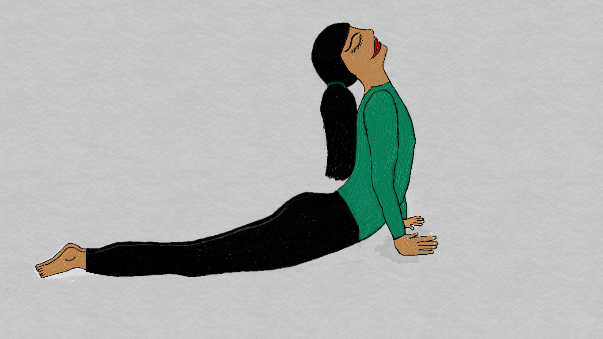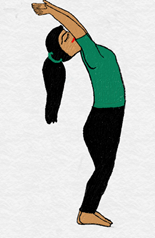|
While most core training programs emphasize on strengthening the abdominal muscles, not enough importance is given to stretching and maintenance of mobility or flexibility. A good program for healthy population will involve both stretching to maintain flexibility and mobility as well as contraction of muscles and soft tissue to maintain stability and strength. This gives a wider range of movement to work with at the same time providing a stable spine and trunk on which these movements will be based.
This brings to forefront the issue of what exercise program to follow: traditional yoga, traditional Pilates, or contemporary exercise regimes (walking, running, bicycling, and swimming, engaging in sports)? Well, worry not, choose what you may, physical therapy is here to the rescue. Imagine your work out to be a multi layered complex movement pattern. Physical therapists can peel these down to the basic movement patterns involved (view from the ground-up or inside-out) in any activity. If the base pattern is flawed, the movements imposed on the base patterns will follow suit. Consider a building standing on a foundational block which is stable and sturdy- the building structure it supports will be strong and stable as well. Since physical therapy considers movement patterns and biomechanics, it is a precise science which may be used to reproduce the movement patterns and eventually automatize the healthy movement patterns till it becomes habit. Having said that, let’s get back to the anterior torso stretch; we will look at all the structures that are involved when the trunk is stretched namely: i) the muscles and tendons like the iliopsoas in hip and lumbar spine region, abdominals (rectus abdominis and obliques in lower to mid trunk), the pectorals and serratus anterior in the chest together with the intercostal muscles, deltoid in the shoulder region, and the sternocleidomastoid and deep neck flexors in the cervical spine/neck region ii) ligaments, like the anterior longitudinal ligament (ALL) which runs along the front of the vertebral bodies iii) fascia, like the aponeurosis of the insertion of transversus abdominus and obliques, linea alba iv) dermal tissue (skin). Various soft tissues have varying elastic properties and stretches must be performed gently and over prolonged periods to achieve flexibility. The anterior torso is stretched through backward bends. These stretches are active stretches and have been considered in various other posts. I will group them here for a clear understanding of anterior torso stretch. Active Dynamic Stretches for Anterior Torso There are several yoga asanas that stretch the hip flexors and the anterior torso. These asanas are intermediate to advanced level as they entail nuances in muscle control, and to be done correctly, should be done in presence of trained instructor and practiced solo after learning them initially. Since they involve back extension which narrows the foraminal space, they are contra-indicated in certain conditions like back ache and neck pain and digestive disorders. i) The Anjaneya asana: You basically start in half-kneeling position with the left foot on the floor in front and the right leg resting on the knee and ball of foot, behind. Slide the right knee back as far as possible and lunge forward on the left foot by shifting the body weight forward and arching the lumbar spine forward into lordosis with arms outstretched overhead to keep spine elongated. This stretches the front of the right hip, thigh, and anterior spine to effectively stretch the psoas and iliacus, the rectus abdominus and the ALL. Hold pose for 2-3 breath cycles and release by first engaging abdominals to bring spine to neutral and then shifting body weight to come out of lunge position. ii) Dhanurasana or the bow pose: This is done in prone position, lying on the stomach with arms by the side of trunk, palms facing upwards. Bend both the knees bringing the heels of feet to ischial tuberosities or sit bones and hold the feet around the ankles with your hands. As you inhale, lift the heels away from the ischial tuberosities and lift the thigh off the floor as the torso lifts up. Ensure both knees are no more than hip width apart. Hold for 2-3 breath cycles and release by first lowering the thighs and torso while bending the knees. Lastly release the hand-hold around the ankles and extend knees. iii) Ustrasana or camel pose: Begin in kneeling position on the mat with knees hip width apart and dorsum of foot resting on the floor. Place both the hands around the waist, thumb in front and fingers around the back. Gently tilt pelvis back by engaging the abdominals and elongate the lumbar spine. Inhale and lift the sternum (breast bone) upwards. Bring the knee and elbow joints closer together by internally rotating hips and externally rotating shoulders. Stay here for 2-3 breath cycles and slowly slide hands down the back, by extending elbow joints, to the heels of feet. Open the shoulders without squeezing the shoulder blades (releasing the pectorals) and extend the neck by eccentric contraction of neck flexors for slow controlled movement. iv) Bhujangasana: This is one of the postures in the Suryanamaskar. It is done from the prone lying position on the mat (facing the floor) with the dorsum of feet resting on the floor. . The legs are resting on the floor from shin to thigh as you begin lifting the torso while extending the lumbar spine and push the chest out as spinal extension continues along the thoracic spine. The spine should simultaneously stay elongated as you achieve a uniform curve, moving up towards mid and upper back. Lastly extend the neck looking upwards and back. The palms facing down, resting on the floor are just behind the shoulders in the beginning and end up in front of shoulders as end posture is reached. The elbows may be in any degree of flexion to complete trunk extension, based on available range of spinal extension and trunk lift from the floor. Finally, you can push the palms into the mat as you open up the chest by rolling shoulder blades down and in (pectoral and deltoid stretch). v) Backward bend or Hasta Uttanasana: This is the second and eleventh posture in the Suryanamaskar. You begin in standing position (tadasana) with feet about hip width apart. Raise hands upwards overhead with the elbows extended, palms open and stretched out, and upper arms in line with ears as you arch the spine backwards in a backward bend. As you begin the movement, the legs start moving forward at the ankle joints as a unit from lower legs to the hips with the hip joints in extension, the pelvis rotates anterior and the spine from the sacrum to the cervical region starts a gradual and uniform extension movement, the shoulders are neutral with shoulder blades rotated upwards as the gaze fixes upwards on hands or ceiling.
2 Comments
B.
5/16/2022 06:37:39 am
Hello.
Reply
5/27/2022 05:19:48 pm
Hello András,
Reply
Your comment will be posted after it is approved.
Leave a Reply. |
Details
AuthorAmi Gandhi is a licensed physical therapist in the state of California. She is the owner of StableMovement Physical Therapy, a small boutique practice in San Jose that offers patient centered, one-on-one, hands-on physical therapy. Archives
March 2018
Categories |




